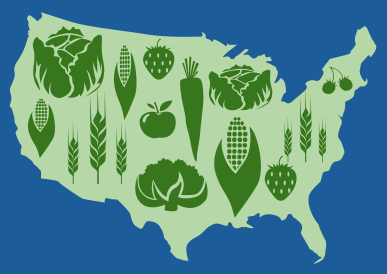The food industry has a fundamental influence on the American food diet and culture. Processed foods with high quantities of high fructose corn syrup, salt, hydrogenated oils and fat are ubiquitous. Fast food and pre-prepared foods are high in energy but have very little nutritional value (Neff, Palmer, McKenzie, & Lawrence, 2009). These images have become the norm:

Retrieved from: http://www.religionnews.com/2013/11/04/washington-voters-weigh-ethics-genetically-modified-foods/

Retrieved from: http://www.domestiphobia.net/category/travel/costa-rica/
We are all fully aware that chronic diseases like obesity, cardiovascular disease, and diabetes are a serious threat to the public health of the United States. Since 1980, the number of obese adults has more than doubled and the number of obese children is now four times what it was thirty years ago (Ikerd, 2010). These rates are not a result of poor self-control or refusal to diet, they stem from the food system.
The biotechnology giant, Monsanto, exhibits this widespread impact. Monsanto’s website labels them as a “sustainable agriculture” company and that their aim is to improve food security around the world. This seems like an admirable goal. In America, 11.1% of people are food insecure and 4.1% have “very low food security” (Neff et al., 2009).
However, Monsanto’s website says, “Our goal is to double yields of corn, soybeans, cotton, and spring-planted canola between 2000 and 2030.” They expect this will also reduce hunger around the world. However, their business is intrinsically benefits industrial agriculture and the imbalance in food production towards unhealthy foods. Clearly they would rather sustain the unsustainable monoculture that already threatens our land and livelihood. Although the claims that genetically engineered food cause serious health issues (such as allergies and cancer) are troubling, the larger issue is the hidden cost of high incentives for commodity crops and extreme barriers for the production, manufacturing, and marketing of healthier, fresh food.
The lack of healthy food options disproportionally affects populations of low-income, ethnic minority, lower education attainment, inner city and rural communities (Neff et al., 2009). African Americans and Latinos suffer from higher rates of heart disease and diabetes and have almost double the national average of food insecurity. The lack of incentives for fresh food is most detrimental to these vulnerable populations.
Affordable and local fruits and vegetables are becoming a rarity due to lack of proper distribution infrastructure, higher production costs, and lack of governmental support (Neff et al., 2009). Fruits and vegetables are not standardized like corn, soy, and wheat, they perishable and need to be sold fresh. This simply does not fit into to our national model of mega-agriculture. Fresh food is less profitable and more susceptible to development; 91% of fruits and 78% of vegetables are produced in urban-influenced areas, where land can be sold to build storefronts and suburbs (American Farmland Trust).
Healthy food disparity can only be fixed with regional empowerment to create systems to improve the distribution of fresh food. Putting a Walmart in a low-income community with limited food access is not the answer (Food & Water Watch). Large businesses consolidate to take money away from communities, farmers and workers in order to benefit the agribusiness sector (Food & Water Watch). On the other hand, small farms and regional fruits and vegetables keep income within a community. Cutting the distance food travels will cut the costs to communities, individuals, and the environment. This creates sustainable and healthy change for all Americans. In my next post, I will explore how this revolution has already begun in communities across the country.
Neff, R.A., Palmer, A.M., McKenzie, S.E., & Lawrence, R.S. (2009). Food Systems and Public Health Disparities. Journal of Hunger and Environmental Nutrition, 3, 169-185. doi: 10.1080/19320240802243241
(2012). Why Walmart Can’t Fix the Food System. Food & Water Watch. Retrieved from: http://www.foodandwaterwatch.org/reports/why-walmart-cant-fix-the-food-system/
Ikerd, John. (2010). Corporate Food System: Consequences for Public Health. Small Farm Today Magazine. Retrieved from: http://web.missouri.edu/ikerdj/papers/SFT-Corporate%20Food%20System%20(11-10).htm
What is Monsanto doing to help? Producing more. Retrieved from: http://www.monsanto.com/improvingagriculture/Pages/producing-more.aspx
What’s Happening to Our Farmland?. American Farmland Trust. Retrieved from: http://www.farmland.org/resources/fote/default.asp


One thought on “What are the impacts on public health?”